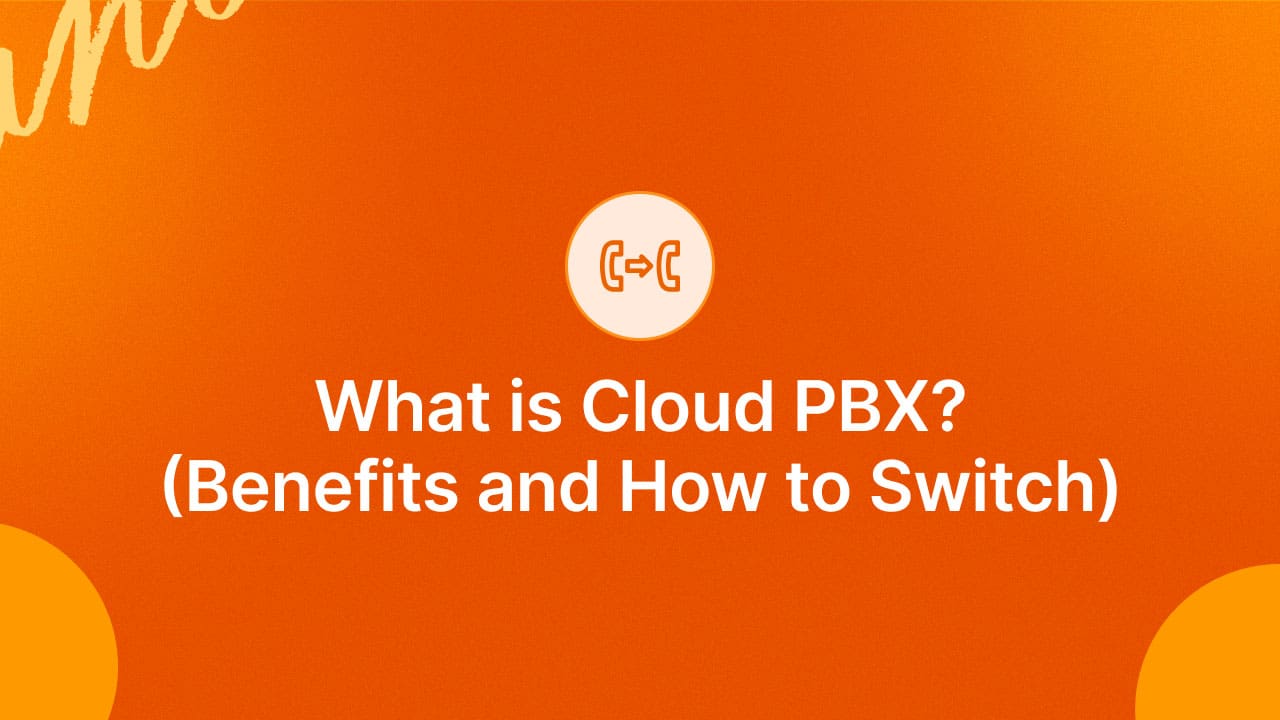A cloud PBX, or virtual PBX, is an internet-based communication system that routes voice calls through scalable remote servers before transmitting to the appropriate extension or department in the workplace. Unlike legacy private branch exchange solutions, cloud-based services offer a lean setup, very little physical hardware, and low initial costs.
While they’ve long been confined to large enterprises with 1,000s of employees, and extensions, cloud PBX has increasingly brought it within the scope of smaller workplaces. Businesses today can get started with such a system for as little as $8 per user and any VoIP-enabled phone or by just downloading an app on their cell phones.
A cloud-based system, with no extensive hardware, or on-site software requirements, coupled with a wide range of integrations, APIs, and partner apps, can add substantial value to businesses and their customers. In this article, we dive deep into this flourishing segment to uncover the exciting times ahead.
Understanding Cloud PBX – How Does It Work?
In simple terms, any cloud solution involves data being stored, or transmitted via the internet, often without any additional device or hardware. Communications have been one of the prime candidates for this disruption, with private branch exchange leading the way when it comes to B2B and business correspondence.
The humble telephone switchboard made way for the on-premise PBX device, and this bulky, expensive, and often cumbersome solution, eventually gave way to the cloud PBX at the turn of this century. The cloud solution’s critical appeal lies in the subtle changes it has since pioneered, helping drive monumental growth in convenience and efficiencies.
With a cloud based PBX, a VoIP-enabled phone plugged into a router, with voice data is converted into data packets before getting transmitted to the provider’s scalable server, which is routed to the correct location. Inbound and internal calls follow the same approach, with extensions, forwarding, and other features coming into play.
Being an entirely cloud-based system, everything about inbound and outbound calls can be managed using a portal provided by the PBX service. Beyond the basic features such as routing, distributing, IVRs, and call recording, the system can easily be integrated with other apps for tracking, analysis, and optimization.
Traditional Versus Cloud PBX Solutions
The early private branch exchange systems first emerged mid-20th Century, when telephones started becoming increasingly popular, and the number of lines, extensions, and the transfer of calls between them required a better approach. Over time, this gave way to automated systems, and programmable devices became the norm.
However, despite their widespread popularity, their installation, infrastructure, and maintenance were often unreasonably expensive for small businesses, with the starting range for an automatic PBX device at $400. They involved further overheads such as licensing fees, rentals, and even the costs of having a trained technician onboard.
A cloud-based solution addresses all these issues with a simple VoIP-based voice and data transmission. The only requirement is a stable internet connection; everything else can be managed and customized via an intuitive portal. At the same time, the PBX service provider requires the regular maintenance and upkeep.
While legacy PBX solutions use either the age-old Public Switched Telephone Network (PSTN) or a Voice Over Internet Protocol Network (VoIP), a cloud PBX system predominantly uses VoIP. However, this has drawbacks, such as variances in internet speeds and vulnerability to cybersecurity threats, among other things.
Key Benefits of Cloud PBX
Cloud PBX systems have been on a steady advancement in the business communications market, especially throughout the pandemic. In this section, we cover certain imoportant cloud PBX benefits, that have since made them crucial for businesses of all sizes.
Low Costs
The biggest selling point of cloud PBX for small businesses is the significantly low initial cost, eliminating the need for any substantial investment in physical hardware or infrastructure. This, coupled with the pay-as-you-go pricing offered by most service providers, and the extensive trials, promos, and offers, results in substantial value for small businesses.
The services are priced on a per-user, per month-basis, so based on the headcount of a business, it can result in substantial overheads, however, even in this regard, most service providers offer volume discounts. As recent trends indicate, the prices are in a race to the bottom, intensifying competition in this space.
Scalability
Legacy on-premise PBX systems have limitations on the number of extensions and parallel call volumes they can handle at any given time.
A cloud based PBX, however, is free from most such restrictions and is often infinitely scalable, with new extensions and additional resources being added instantaneously.
Scalability remains key to avoiding missed connections and disgruntled customers in the long run for businesses that are expected to witness upsurges in call volumes.
Features, Integrations & Customizations
PBX solutions are hosted on the cloud, allowing for a wide range of integrations, customizations, apps, and features, adding substantial value for businesses and customers. It includes simple features such as IVR, call forwarding and distribution, advanced tracking, and analytics.
Many businesses integrate their contact centers with CRM solutions to effectively monitor, track, and optimize their sales, and support operations. With the right approach, a cloud-hosted PBX solution can unlock a treasure of data, providing solid insights across all key segments within an organization.
Reliability
Businesses remain vulnerable to power outages and disruptions in internet connectivity when working with an on-premise PBX. With a cloud solution, however, forwarding calls from a desk phone to a cell phone can be done at the click of a button. This proved useful during the pandemic when stay-at-home orders were announced overnight.
Such reliability forms the core component of business continuity, with data, contacts, and operations all stored on the cloud, with no untoward incident, like theft, fire, or natural disaster likely to derail operations.
No Maintenance & Up-Keep
With a cloud PBX phone system, businesses need not hire an on-site technician, engage a service provider, or even concern themselves with the maintenance and upkeep of their communication systems.
Most reliable service providers ensure 24/7 uptime and maintain a distributed presence across servers to ensure issues are isolated, and service remains unaffected. Any concerns or issues are similarly troubleshot instantly to make sure nothing comes in the way of reliable connectivity.
Start your 14 day Free Trial Upgrade Your Business Communications With an AI Cloud Phone System
How To Switch To A Cloud PBX?
Transitioning to a cloud PBX takes extensive planning and seamless execution. To ensure a perfect shift, without missing out on calls, or frustrating customers, there are a few tried and tested best practices to abide by.
Choose The Right Service Provider
Businesses today are spoilt for choice when it comes to cloud PBX systems.
With innumerable services, add-ons, customizations, and differing price points, it becomes critical to approach this decision with much thought and analysis.
Identify Operational Risks
Any change in an organization of any size comes with operational risks, and the first step in mitigating them is identifying them. While dealing with a PBX solution provider, or technician, it is crucial to ask questions on the downtimes involved, along with the best, and worst case scenarios for getting things back to normal. Any plans thereof should be based on the estimates received, with contingencies already in place.
Training
It goes without saying that the staff must be at the crux of this transition, and any new technology is bound to have a learning curve that needs to be addressed.
Most leading PBX solution providers have their own training program to quickly address this gap in most employees, if not, live demonstrations must be handled by the business before things get back to normal.
Tracking & Optimization
It takes a while for the changes to assimilate, and during this time, it is recommended to stay on top of performance to track any variances and have them addressed right away. The extensive tracking tools and integrations cloud PBX offers could come in handy here.












